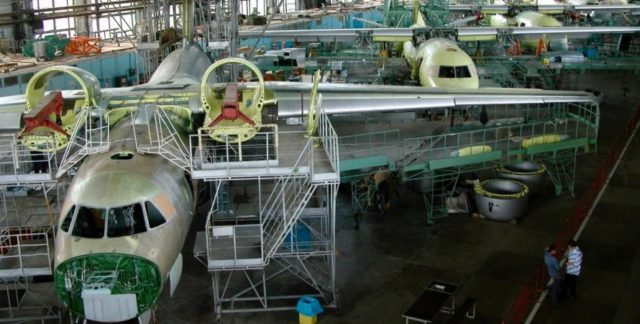
Kharkiv State Aviation Production Enterprise Enters Freefall
Publication: Eurasia Daily Monitor Volume: 18 Issue: 117
By:

The sudden collapse of the Union of Soviet Socialist Republics (USSR), in December 1991, and fracturing into 15 independent states effectively destroyed its unified, centrally planned, autarkic economy. The massive former Soviet defense sector was particularly hard-hit; during the 1990s, it scrambled to cope with hyperinflation, raw material shortages and cancelations of orders, all while attempting to reorient itself toward the global capitalist economy. Three decades later, the reverberations continue throughout the post-Soviet space but particularly in Ukraine, where many of the USSR’s major defense industries were located, from shipbuilding to aircraft and engine production. The latest Soviet defense legacy facility to fall victim to post-Soviet Ukraine’s arduous political and economic environment is the nearly century-old Kharkiv State Aircraft Manufacturing Company (KhAZ). Problems from state mismanagement have gradually intensified at this aerospace manufacturer to the point that the Supreme Rada (Ukrainian parliament) is now considering draft legislation to partially privatize the troubled company.
What eventually became KhAZ was founded on September 17, 1926, on the basis of Kharkov aircraft repair shops, which had opened in 1923. The German aviation company Junkers Flugzeug und Motorenwerke AG constructed them before Adolf Hitler came to power. The enterprise was part of Weimar Germany’s efforts to cover up its military collaboration with the Soviet Union to evade the constraints placed on the German Armed Forces by the Treaty of Versailles (Ekonomika Segodnia, June 29). Throughout the Soviet era, KhAZ produced both military and civilian aircraft; but in the three decades since the collapse of the USSR, the firm has struggled both to modernize and secure new orders and funding, while downsizing and falling ever deeper into debt.
Last month (June 16), the Ukrainian state defense corporation Ukroboronprom’s deputy general director for production, Igor Fomenko, spoke candidly about the problems at KhAZ, admitting that state ownership and management had failed: “To be honest, the state is not able to completely rebuild the company, and therefore it is necessary to attract [outside] investment” (Ukrinform, June 16). And during a later interview on the Simon TV channel, KhAZ’s Director Oleksandr Krivokon stated that staffing shortages meant the facility was no longer capable of building aircraft, much less restoring serial production. While “official” statistics had KhAZ employing 1,580 workers, the real number was in fact roughly 100, with an average age of 60, he revealed (Status Quo, June 26). According to Krivokon, mismanagement by the government has reduced the KhAZ facility to a four-hour work week, and it has lost its “gold” reserve of qualified specialists capable of building aircraft (Ekonomika Segodnia, June 28).
The president of the business alliance Association of Aircraft-Manufacturing Enterprises of Ukraine (UkrAviaProm), Viktor Popov, subsequently criticized Krivokon for saying that KhAZ could no longer build aircraft, remarking, “The An-74 [short-to-medium-range transport jet] is a niche product that is in demand today. And those issues [hampering production] that are related to import substitution, increasing of production, of course, do exist, and they are very difficult. But the most important thing is to go down this road instead of saying that this cannot be done.” These kinds of negative statements from the likes of Krivokon harm relations with foreign customers, such as Turkmenistan, Kazakhstan, Iran and Egypt, that operate KhAZ-built An-74s or An-140s, Popov added (Status Quo, July 2).
In any case, the grim fiscal reality is that KhAZ’s liabilities now exceed four billion hryvna ($147 million) (UNIAN, April 15). The Ukrainian government has belatedly acknowledged the country’s aerospace-sector problems and is seeking to implement the “Aviation Industry Revival Strategy to 2030,” approved in 2018 under then-president Petro Poroshenko. On June 24, President Volodymyr Zelenskyy issued a decree to implement the decision “On the Development of the Aircraft-Building Industry in Ukraine,” which had been adopted on June 4 by the National Security and Defense Council (NSDC) (President.gov.ua, June 24). The decree’s more important directives include developing production, design, research and human resources, fostering aviation production by concluding agreements on strategic cooperation with foreign partners, and promoting their products in foreign markets, all while improving the organizational structure of Ukraine’s aircraft industry management (Strana.ua, June 25). As for domestic markets for KhAZ aircraft, the directive instructs the Ukrainian Ministry of Defense to include the company’s output in the state’s target acquisition programs (Fokus, June 25).
Russian observers have harshly critiqued the optimistic pronouncements. While the Ukrainian defense ministry was instructed to upgrade the military’s fleet of aircraft, helicopters and drones, along with military transport aircraft, Ukraine cannot currently produce any of this ordnance. KhAZ is furthermore still unable to manufacture An-74s without Russian components, and its last An-74 production line was transferred to Kazakhstan seven years ago—in 2014 (RIA Novosti, July 1). As for the Ukrainian government’s search for foreign direct investment (FDI), in 2017 KhAZ reached an agreement with the United States’ Oriole Capital Group about possibly investing $150 million; but the contract was never fulfilled (Politikus, September 13, 2020).
The problems of the Kharkiv Aircraft Plant are emblematic of the tribulations faced by the post-1991 collapse of the Soviet military-industrial complex at large, but particularly in Ukraine. Hyperinflation, the collapse of domestic markets, raw material and distribution shortages, rising corruption, and a bleeding out of a skilled workforce have all impacted the USSR’s centrally planned industrial complex, which for decades had supported the world’s second-largest military forces. With the exception of hyperinflation, all of these problems have persisted and intensified at KhAZ due to incompetence and venal administration, eventually rendering the facility a husk of its former self. The Ukrainian government’s efforts to sell stock in KhAZ to a foreign buyer, thus, look increasingly unlikely to come to fruition.



